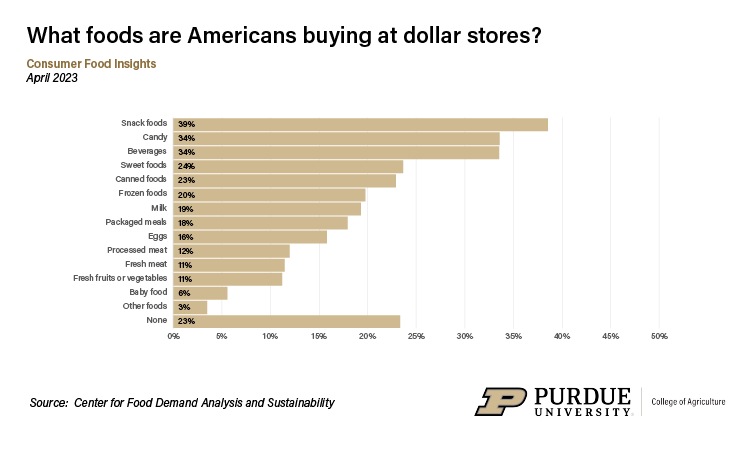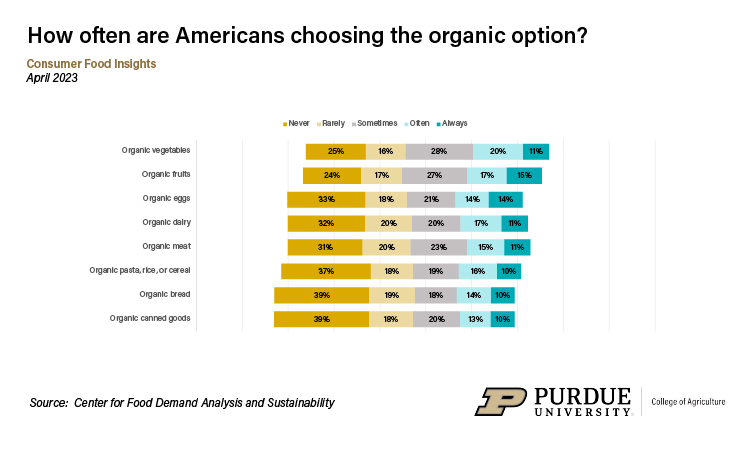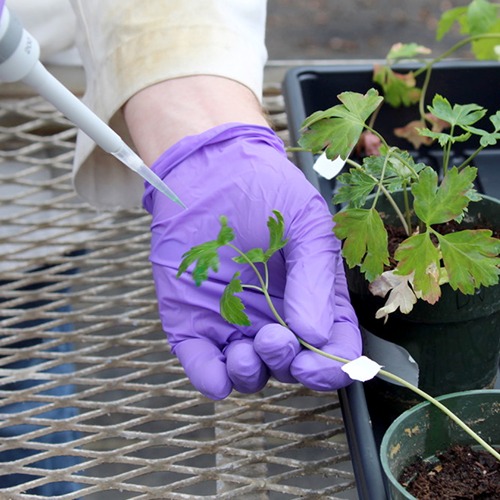A
market for an expanded grocery selection at dollar stores potentially exists, especially with consumers who live less than 10 minutes away, according to data reported in the April Consumer Food Insights report.
The survey-based report out of Purdue University’s Center for Food Demand Analysis and Sustainability assesses food spending, consumer satisfaction and values, support of agricultural and food policies, and trust in information sources. Purdue experts conducted and evaluated the survey, which included 1,200 consumers across the U.S.
April’s report assesses differences in food behaviors by food security status rather than demographics. The report includes the first questions center researchers have asked about consumer behavior and food selection at dollar stores.
 Foods that Dollar Store Shoppers Purchased in Last 30 Days, Apr. 2023
Foods that Dollar Store Shoppers Purchased in Last 30 Days, Apr. 2023 “More than half of Americans have recently shopped at a dollar store,” said Jayson Lusk, the head and Distinguished Professor of Agricultural Economics at Purdue, who leads the center. “When it comes to food, many of these purchases are snack items. If consumers do pick up more food at a dollar store, it makes sense that people typically buy canned or frozen foods since these are the easiest options for dollar stores to stock.”
While only a small percentage of consumers shop for groceries at dollar stores, there could be a market for an expanded food selection since 50% of those surveyed reported that a full-service grocery would be a draw.
“Plus, nearly 60% of consumers say that they live within 10 minutes of a dollar store, which has potential for capitalizing on access issues,” Lusk said.
In the food spending category, the slow easing of food inflation continues. Data from this summer’s reports will provide a helpful picture of how consumers are doing.
“If people go out and spend more at bars and restaurants, as one would expect, then we could say that consumers are feeling fairly confident,” Lusk said. “But if food away from home spending does not increase in our data, especially as food away from home inflation continues to pick up according to official measures, then we might have some questions.”
Lacking pre-January 2022 survey data, the Purdue researchers are unable to compare current responses to times of low inflation. Even so, Lusk said, “It seems that consumers have some degree of elevated inflation baked into their expectations with their 4.3% estimation of future inflation.”
Additional key results include the following:
- Total food spending is up 7% from this time last year, while consumers similarly estimate annual food inflation to be about 7%.
- Vegetables and fruits are the most popular organic items, but less than a third of consumers often or always choose organic.
The food behaviors of food-secure and -insecure households differ relatively little on many common shopping choices. Still, it is important to recognize the differences that do exist between the households, said Sam Polzin, a food and agriculture survey scientist for the center and co-author of the report.
“Those facing very low food security are in a more precarious place,” Polzin said. “Over 40% rely on food aid and over 80% report effectively living paycheck to paycheck with regards to food purchasing. They also have a much more negative view toward their own diets, which we might expect would have a cumulative negative effect on overall well-being. They eat at home more often, prefer generic brands, and aren’t buying more expensive products like wild-caught fish or organics as much.”
In some ways, however, Polzin adds, “Food behaviors between food-secure and -insecure households don’t differ as much as we might expect or differ in ways we might not expect.”
For example, people in food-insecure households garden at a higher rate. They are just as likely to buy local foods or check for natural food labels and appear to compost more often.
April’s report also includes a section on how often Americans choose the organic option. These data broadly help show that fruits and vegetables are the most popular organic category.
 Frequency the Consumers Choose the Organic Food Option, Apr. 2023
Frequency the Consumers Choose the Organic Food Option, Apr. 2023 “Since organics are not purchased that often, we can say that people are likely overstating how often they select these foods,” Polzin noted. “Since organics have one of the largest halos with regards to nutrition, naturalness and the environment, social desirability bias is probably a common factor contributing to this phenomenon.”
Lusk further discusses the report in his blog.
The Center for Food Demand Analysis and Sustainability is part of Purdue’s Next Moves in agriculture and food systems and uses innovative data analysis shared through user-friendly platforms to improve the food system. In addition to the Consumer Food Insights report, the center offers a portfolio of online dashboards.





